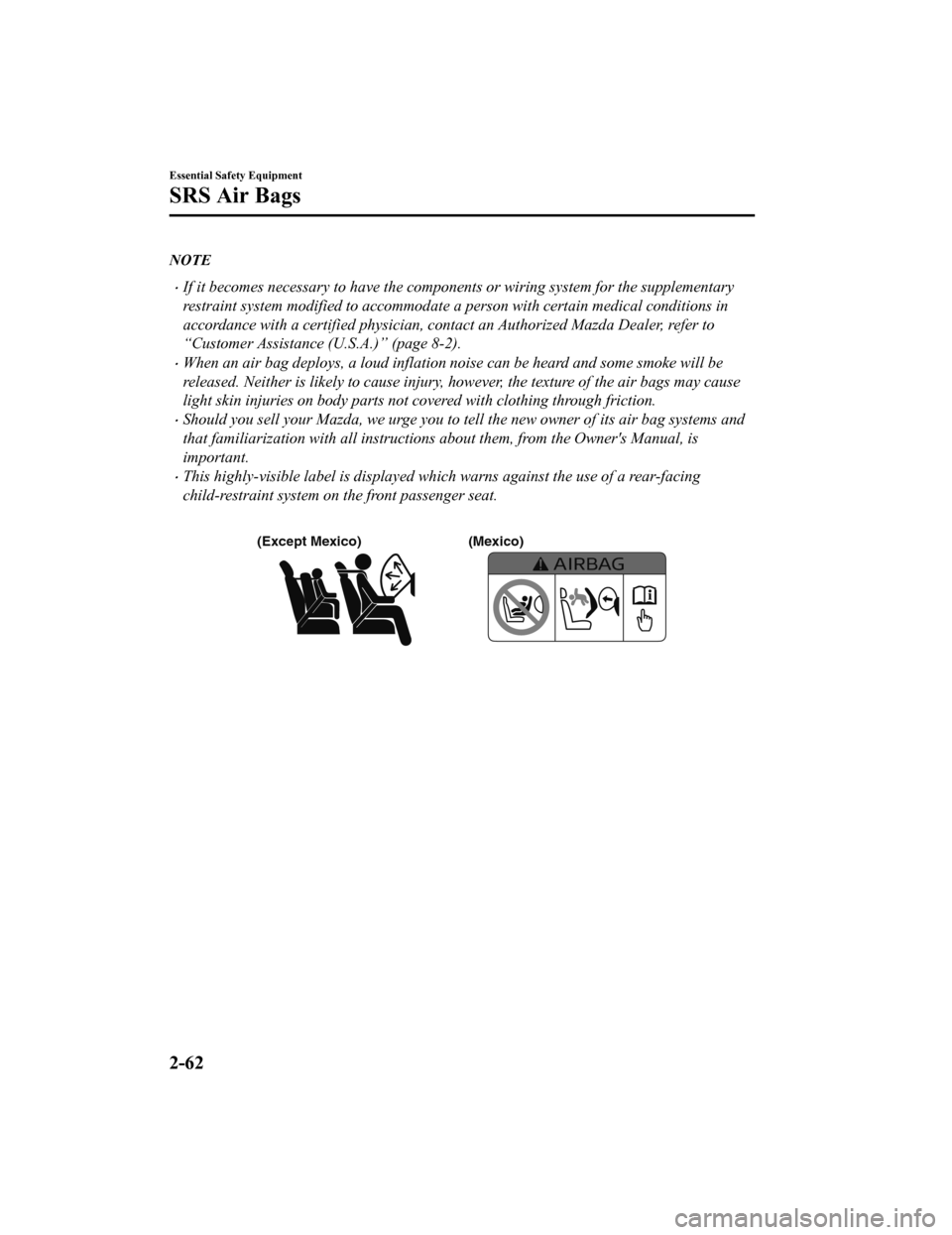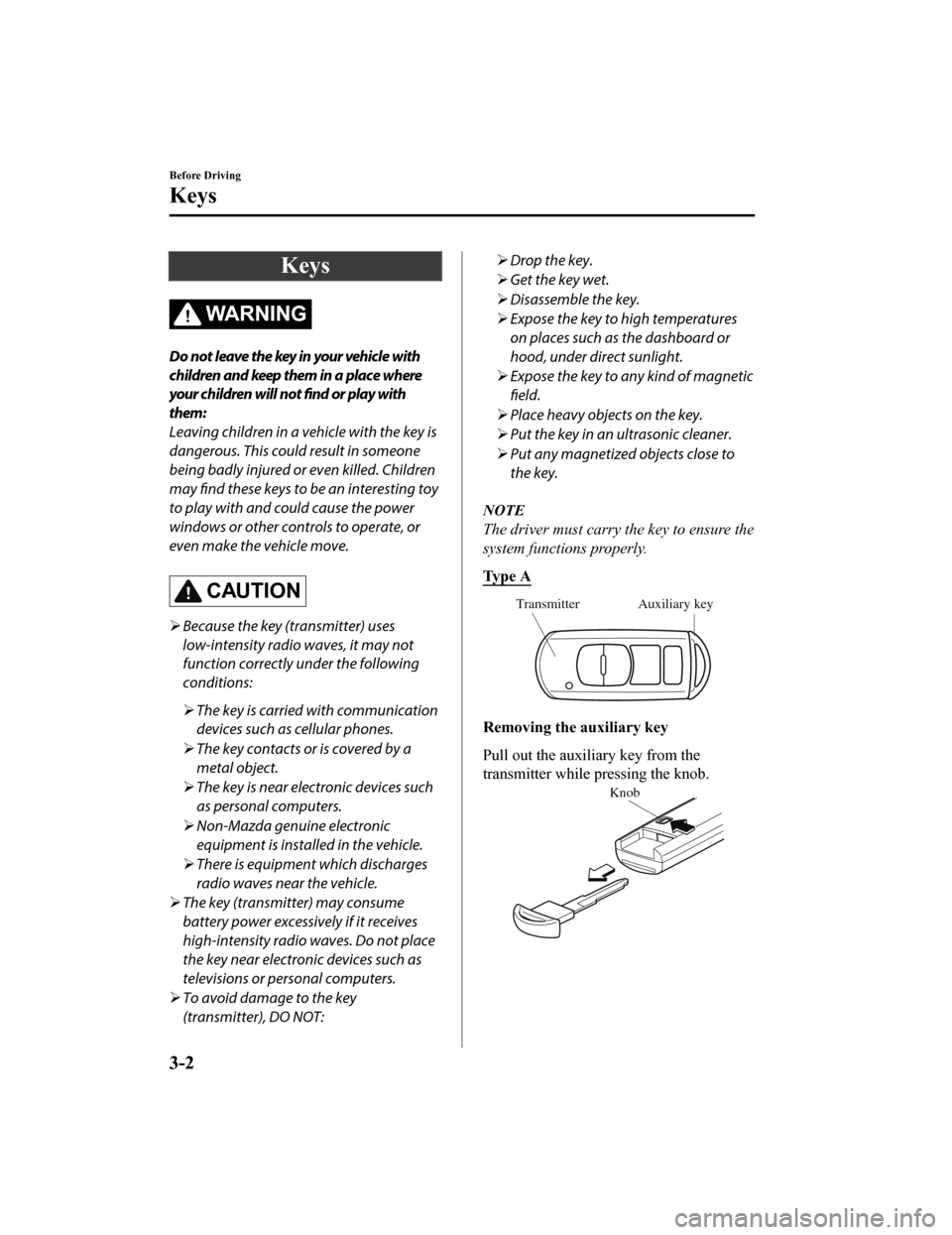light MAZDA MODEL CX-5 2020 (in English) Owner's Manual
[x] Cancel search | Manufacturer: MAZDA, Model Year: 2020, Model line: MODEL CX-5, Model: MAZDA MODEL CX-5 2020Pages: 714
Page 72 of 714

WA R N I N G
Seat belts must be worn in air bag equipped vehicles:
Depending only on the air bags for protection during an accident is dangerous. Alone, air
bags may not prevent serious injuries. The appropriate air bags can be expected to
inflate
only in the first accident, such as frontal, near frontal or side collision s or roll-over accidents
that are at least moderate. Vehicle occu pants should always wear seat belts.
Children should not ride in the front passenger seat:
Placing a child, 12 years or under, in the front seat is dangerous. The child could be hit by a
deploying air bag and be seriously injured or even killed. A sleeping child is more likely to lean
against the door and be hit by the side air ba g in moderate collision to the front-passenger
side of the vehicle. Whenever possible, always secure a child 12 years and under on the rear
seats with an appropriate child-restrain t system for the child's age and size.
Never use a rear-facing child-restraint system in the front seat with an air bag that could
deploy:
Rear-facing child-restraint systems on the front seat are particularly dangerous even though
you may feel assured that a front passenger air ba g will not deploy based on the fact that the
front passenger air bag deactivation indicator light illuminates. The child-restraint system
can be hit by a deploying air bag and moved viol ently backward resulting in serious injury or
death to the child.
Do not sit too close to the driver and front passenger air bags:
Sitting too close to the driver and front passenger air bag modules or placing hands or feet on
them is extremely dangerous. The driver and fron t passenger air bags inflate with great force
and speed. Serious injuries could occur if some one is too close. The driver should always hold
onto only the rim of the steering wheel. The front seat passenger should keep both feet on the
floor. Front seat occupants should adjust their seats as far back as possible and always sit
upright against the seatbacks wi th seat belts worn properly.
Essential Safety Equipment
SRS Air Bags
2-58
CX-5_8HX6-EA-19I_Edition2_old 2019-9-19 9:26:07
Page 76 of 714

NOTE
’éĘIf it becomes necessary to have the components or wiring system for the supplementary
restraint system modified to accommodate a person with certain medical conditions in
accordance with a certified physician, contact an Authorized Mazda Dealer, refer to
ŌĆ£Customer Assistance (U.S.A.)ŌĆØ (page 8-2).
’éĘWhen an air bag deploys, a loud inflation noise can be heard and some smoke will be
released. Neither is likely to cause injury, however, the text ure of the air bags may cause
light skin injuries on body parts not covered with clothing through friction.
’éĘShould you sell your Mazda, we urge you to tell the new owner of its air bag systems and
that familiarization with all instructions about them, from the Owner's Manual, is
important.
’éĘThis highly-visible label is displayed wh ich warns against the use of a rear-facing
child-restraint system on the front passenger seat.
(Except Mexico) (Mexico)
Essential Safety Equipment
SRS Air Bags
2-62
CX-5_8HX6-EA-19I_Edition2_old 2019-9-19 9:26:07
Page 78 of 714

Roll-over sensor*, crash sensors, and diagnostic module (SAS unit)
Front seat belt pretensioners (page 2-31)
Front air bag sensors
Side crash sensors
Air bag/front seat belt pretensioner system warning light (page 7-26)
Side and curtain inflators and air bags
Front passenger air bag deactivation indicator light* (page 2-71)
Front passenger occupant classification sensor* (page 2-71)
Front passenger occupant classification module*
Essential Safety Equipment
SRS Air Bags
2-64*Some models.
CX-5_8HX6-EA-19I_Edition2_old2019-9-19 9:26:07
Page 81 of 714

When the air bag crash sensors detect a side impact of greater than moderate force, the
curtain air bag inflates quickly and helps to reduce injury mainly to the rear outboard
passenger's head caused by directly hitting interior parts such as a door or window.
For more details about air bag deployment, refer to "SRS Air Bag Deployment Criteria"
(page 2-68).
In a side impact:
Greater than moderate impact to one side of the vehicle will cause the curtain air bag on that
side only to inflate.
Only one side curtain air bag will
deploy on the side of the vehicle
that receives the force of an impact.
(With Front Passenger Occupant Classification System)
In a roll-over:
In response to a vehicle roll-over, both curtain air bags inflate.
Both curtain air bags will
deploy after the roll-over
accident is detected.
Ō¢╝ Warning Light/Beep
A system malfunction or operation conditions are indicated by a warning.
Refer to Contact Authorized Mazda Dealer and Have Vehicle Inspected on page 7-26.
Refer to Warning Sound is Activated on page 7-43.
Essential Safety Equipment
SRS Air Bags
2-67
CX-5_8HX6-EA-19I_Edition2_old
2019-9-19 9:26:07
Page 85 of 714

Front Passenger Occupant Classification System*
First, please read "Supplemental Restraint System (SRS) Precautions" (page 2-56) carefully.
Ō¢╝Front Passenger Occupant Classification Sensor
Your vehicle is equipped with a front passenger occupant classification sensor as a part of
the supplemental restraint system. This sensor is equipped in the front passenger's seat
cushion. This sensor measures the electrostatic capacity of the front passenger's seat. The
SAS unit is designed to preven
t the front passenger front and side air bags and seat belt
pretensioner system from deploying if the front passenger air bag deactivation indicator
light turns on.
To reduce the chance of injuries caused by deployment of the front passenger air bag, the
system deactivates the front passenger front and side air bags and also the seat belt
pretensioner system when the front passenger air bag deactivation indicator light turns on.
Refer to the following table for the front passenger air bag deactivation indicator light
illumination conditions.
This system shuts off the front passenger front and side air bags and seat belt pretensioner
system, so make sure the front passenger air bag deactivation indicator light turns on
according to the following table.
The air bag/front seat belt pretensioner system warning light flashes and the front passenger
air bag deactivation indicator light illuminates if the sensors have a possible malfunction. If
this happens, the front passenger front and side air bags and seat belt pretensioner system
will not deploy.
Front passenger air bag deactivation indicator light
This indicator light turns on to remind you that the front passenger front and side air bags
and seat belt pretensioner will not deploy during a collision.
Essential Safety Equipment
SRS Air Bags
*Some models.2-71
CX-5_8HX6-EA-19I_Edition2_old 2019-9-19 9:26:07
Page 86 of 714

If the front passenger occupant classification sensor is normal, the indicator light turns on
when the ignition is switch ed ON. The light turns off af ter a few seconds. Then, the
indicator light turns on or is off under the following conditions:
Front passenger air bag deactivation indicator light on/off condition chart
Condition detected by the front passenger occupant classifica- tion system Front passenger air
bag deactivation indi- cator light Front passenger front
and side air bags Front passenger seat
belt pretensioner sys- tem
Empty (Not occupied) OnDeactivated Deactivated
A child less than 1 year old is
seated in a child-restraint system On
Deactivated Deactivated
Child
*1On or off Deactivated or ready Deactivated or ready
Adult
*2Off Ready Ready
*1 The occupant classification sensor may not detect a child seated on the seat, in a child-restraint system, or a
junior seat depending on the child's physical size and seated posture.
*2 If a smaller adult sits on the front passenger seat, the sensors might detect the person as being a childdepending on the person's physique.
The curtain air bag is ready for inflating re gardless of what the front passenger air bag
deactivation indicator light on/off condition chart indicates.
If the front passenger air bag deactivation indicat or light does not turn on when the ignition
is switched ON and does not turn on as indi cated in the front passenger air bag deactivation
indicator light on/off condition chart, do not allow an occupant to sit in the front passenger
seat and consult an Authorized Mazda Dealer as soon as possible. The system may not work
properly in an accident.
WA R N I N G
Do not allow an occupant in the front passenger's seat to sit with a posture which makes it
difficult for the front passenger occupant classification sensor to detect the occupant
correctly:
Sitting in the front passenger's seat with a posture which makes it difficult for the front
passenger occupant classification sensor to dete ct the occupant correctly is dangerous. If the
front passenger occupant classification sensor ca nnot detect the occupant sitting on the front
passenger's seat correctly, the front passenge r front and side air bags and pretensioner
system may not operate (non-deploy) or they may operate (deploy) accidentally. The front
passenger will not have the su pplementary protection of the air bags or the accidental
operation (deployment) of the air bags could result in serious injury or death.
Under the following conditions, the front passe nger occupant classification sensor cannot
detect a passenger sitting on the front passe nger's seat correctly and the deployment/
non-deployment of the air bags cannot be contro lled as indicated in the front passenger air
bag deactivation indicator light on /off condition chart. For example:
Essential Safety Equipment
SRS Air Bags
2-72
CX-5_8HX6-EA-19I_Edition2_old 2019-9-19 9:26:07
Page 88 of 714

The front passenger front and side air bags and seat belt pretensioner systems will deactivate
if the front passenger air bag deactivation indicator light turns on.
CAUTION
’āś To assure proper deployment of the front air bag and to prevent damage to the sensor in
the front seat cushion:
’āś Do not place sharp objects on the front seat cushion or leave heavy luggage on them.
’āś Do not spill any liquids on the front seats or under the front seats.
’āś To allow the sensors to function properly, always perform the following:
’āś Adjust the front seats as far back as possibl e and always sit upright against the seatbacks
with seat belts worn properly.
’āś If you place your child on the front passenger seat, secure the child-restraint system
properly and slide the front passenger seat as far back as possible (page 2-48).
NOTE
’éĘThe system requires about 10 seconds to alte rnate between turning the front passenger
front and side air bags and seat belt pretensioner system on or off.
’éĘThe front passenger air bag deactivation indicato r light may turn on repeatedly if luggage
or other items are put on the front passenger seat, or if the temperature of the vehicle's
interior changes suddenly.
’éĘThe front passenger air bag deactivation indicato r light may turn on for 10 seconds if the
electrostatic capacity on the front passenger seat changes.
’éĘThe air bag/front seat belt pretensioner system warning light might turn on if the front
passenger seat receives a severe impact.
’éĘIf the front passenger air bag deactivation indicator light does not turn on after installing
a child-restraint system on the front passenger seat, first, re-install your child-restraint
system according to the procedure in this owner's manual. Then, if the front passenger air
bag deactivation indicator light still does not tu rn on, install the child-restraint system on
the rear seat and consult an Authorized Mazda Dealer as soon as possible.
’éĘIf the front passenger air bag deactivation i ndicator light turns on when an occupant is
seated directly in the front passenger seat, have the passenger re-adjust their posture by
sitting with their feet on the floor, and th en re-fastening the seat belt. If the front
passenger air bag deactivation i ndicator light remains turned on, move the passenger to
the rear seat. If sitting in the rear seat is no t possible, slide the front passenger seat as far
back as possible. Consult an Authorized Mazda Dealer as soon as possible.
Essential Safety Equipment
SRS Air Bags
2-74
CX-5_8HX6-EA-19I_Edition2_old 2019-9-19 9:26:07
Page 89 of 714

Constant Monitoring
The following components of the air bag systems are monitored by a diagnostic system:
’éĘFront air bag sensors
’éĘCrash sensors, and diagnostic module (SAS unit)
’éĘSide crash sensors
’éĘAir bag modules
’éĘFront seat belt pretensioners
’éĘAir bag/Front seat belt pretensioner system warning light
’éĘRelated wiring
(With Front Passenger Occupant Classification System)
’éĘFront passenger occupant classification sensor
’éĘFront passenger occupant classification module
’éĘFront passenger air bag deactivation indicator light
The diagnostic module continuously monitors the system's readiness. This begins when the
ignition is switched ON and continue s while the vehicle is being driven.
Essential Safety Equipment
SRS Air Bags
2-75
CX-5_8HX6-EA-19I_Edition2_old 2019-9-19 9:26:07
Page 92 of 714

Keys
WA R N I N G
Do not leave the key in your vehicle with
children and keep them in a place where
your children will not find or play with
them:
Leaving children in a vehicle with the key is
dangerous. This could result in someone
being badly injured or even killed. Children
may find these keys to be an interesting toy
to play with and could cause the power
windows or other controls to operate, or
even make the vehicle move.
CAUTION
’āśBecause the key (transmitter) uses
low-intensity radio waves, it may not
function correctly under the following
conditions:
’āś The key is carried with communication
devices such as cellular phones.
’āś The key contacts or is covered by a
metal object.
’āś The key is near electronic devices such
as personal computers.
’āś Non-Mazda genuine electronic
equipment is installed in the vehicle.
’āś There is equipment which discharges
radio waves near the vehicle.
’āś The key (transmitter) may consume
battery power excessively if it receives
high-intensity radio waves. Do not place
the key near electronic devices such as
televisions or personal computers.
’āś To avoid damage to the key
(transmitter), DO NOT:
’āś Drop the key.
’āś Get the key wet.
’āś Disassemble the key.
’āś Expose the key to high temperatures
on places such as the dashboard or
hood, under direct sunlight.
’āś Expose the key to any kind of magnetic
field.
’āś Place heavy objects on the key.
’āś Put the key in an ultrasonic cleaner.
’āś Put any magnetized objects close to
the key.
NOTE
The driver must carry the key to ensure the
system functions properly.
Ty p e A
Auxiliary key
Transmitter
Removing the auxiliary key
Pull out the auxiliary key from the
transmitter while pressing the knob.
Knob
Before Driving
Keys
3-2
CX-5_8HX6-EA-19I_Edition2_old 2019-9-19 9:26:07
Page 94 of 714

Keyless Entry System
This system uses the key buttons to
remotely lock and unlock the doors and
the liftgate, and opens/closes the liftgate.
The system can start the engine without
having to take the key out of your purse or
pocket.
It can also help you signal for attention or
help.
Operating the theft-deterrent system is
also possible on theft-deterrent
system-equipped vehicles.
System malfunctions or warnings are
indicated by the following warning lights
or beeps.
For vehicles with the type A/type B
instrument cluster, check the displayed
message for more information and, if
necessary, have the vehicle inspected at an
Authorized Mazda Dealer, according to
the indication.
’éĘKEY Warning Light (Red)
Refer to Contact Authorized Mazda
Dealer and Have Vehicle Inspected on
page 7-26.
Refer to Taking Action on page 7-33.
’éĘIgnition Not Switched Off (STOP)
Warning Beep
Refer to Ignition Not Switched Off
(STOP) Warning Beep on page 7-44.
’éĘKey Removed from Vehicle Warning
Beep
Refer to Key Removed from Vehicle
Warning Beep on page 7-44.
If you have a problem with the key,
consult an Authorized Mazda Dealer.
If your key is lost or stolen, consult an
Authorized Mazda Dealer as soon as
possible for a replacement and to make the
lost or stolen key inoperative.
CAUTION
Radio equipment like this is governed by
laws in the United States.
Changes or modifications not expressly
approved by the party responsible for
compliance could void the user's authority
to operate the equipment.
NOTE
’éĘThe keyless entry system operation may
vary due to local conditions.
’éĘThe keyless entry system is fully
operational (door/liftgate lock/unlock)
when the ignition is switched off. The
system does not operate if the ignition is
switched to any position other than off.
’éĘIf the key does not operate when
pressing a button or the operational
range becomes too small, the battery
may be weak. To install a new battery,
refer to Key Battery Replacement (page
6-44).
’éĘBattery life is about 1 year. Replace the
battery with a new one if the KEY
indicator light (green) flashes in the
instrument cluster (for vehicles with a
type A/type B instrument cluster (page
4-13, 4-30), messages are displayed
in the instrument cluster). Replacing the
battery about once a year is
recommended because the KEY warning
light/indicator light may not illuminate
or flash depending on the rate of battery
depletion.
Before Driving
Keys
3-4
CX-5_8HX6-EA-19I_Edition2_old 2019-9-19 9:26:07